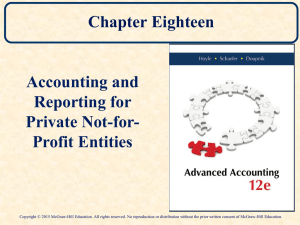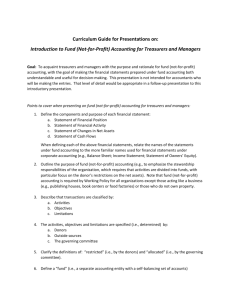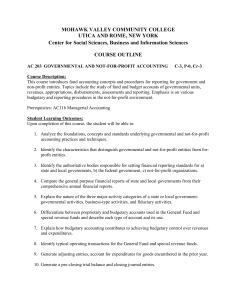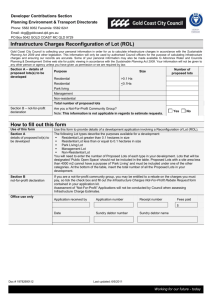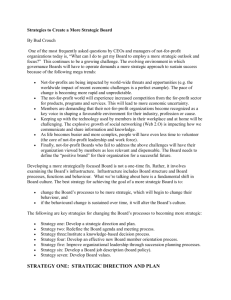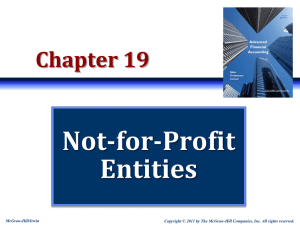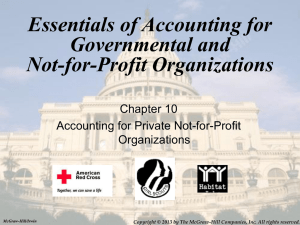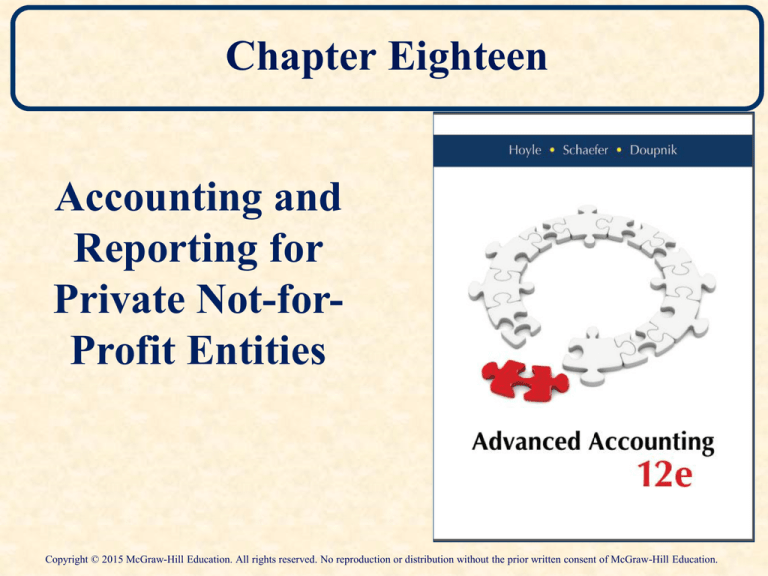
Chapter Eighteen
Accounting and
Reporting for
Private Not-forProfit Entities
Copyright © 2015 McGraw-Hill Education. All rights reserved. No reproduction or distribution without the prior written consent of McGraw-Hill Education.
Not-for-Profit Organizations
General Characteristics
They receive contributions from donors who do not
expect a return of equal financial value
Their operating purpose is not providing goods and
services for profit
They do not have ownership interests as do for- profits
May be governmental or private
Charitable
Educational
Civic organizations
Political parties
Trade organizations
18-2
Learning Objective 18-1
Understand the basic composition
of financial statements produced for a
private not-for-profit entity.
18-3
Not-for-Profit Organizations
Several basic goals form the framework for
generally accepted accounting principles for private
not-for-profit entities, including:
1. Financial statements should focus on the entity as
a whole.
2. Reporting requirements for private not-for-profit
entities should be similar to those applied by forprofit businesses unless critical differences exist in
the nature of the transactions or the
informational needs of financial statement users.
18-4
Not-for-Profit Organizations
FASB Statement (SFAS) 116, “Accounting for
Contributions Received and Contributions Made,”
established guidelines for determining when and
how donations should be recognized and reported.
FASB Statement 117, “Financial Statements of Notfor-Profit Organizations,” specified the required
content and format for financial statements
distributed by these organizations.
18-5
Learning Objective 18-2
Describe the differences in assets that are
unrestricted, temporarily restricted, or
permanently restricted and explain
the method of reporting these categories.
18-6
Financial Reporting
Three critical differences exist between private not-forprofit and for-profit businesses.
1) Donations received by private entities are
transactions that have no counterpart in commercial
businesses.
2) The private entities’ donations often have donorimposed restrictions.
3) No single figure describes performance as effectively
as net income does for commercial entities.
18-7
Learning Objective 18-3
Explain the purpose and
construction of a statement
of functional expenses.
18-8
Statement of Functional Expense
Statement provides a detailed analysis of expenses by
function and object.
Columns represent functions followed by supporting
services.
Categories are the same as those reported on the
statement of activities and column totals agree with
the operating expenses on that statement.
Rows list expenses according to their nature.
Allocation of joint fund-raising & program service
costs is permitted only when certain criteria are met.
18-9
Learning Objective 18-4
Report the various types of
contributions that a private
not-for-profit entity can
receive.
18-10
Accounting for Contributions
Contributions, unconditional transfers of cash or other
resources, are recorded as support at fair value in the
period received.
Restricted gifts are not the same as conditional gifts.
Donors of restricted contributions specify how they are to
be used. These gifts are recognized as temporarily or
permanently restricted assets when a promise is received.
Conditional promises that require a future action before
asset will be transferred from the donor are not
recognized until conditions are met.
18-11
Accounting for Contributions
Donations of works of art and historical treasures are
generally not recognized, but disclosure is required.
Exchanges, such as member dues, are treated as
accrual revenue.
Contributed services are recognized as revenue if one of
two conditions is met:
1. The service creates or enhances a nonfinancial asset,
OR
2. The services are specialized and would have had to be
purchased otherwise.
18-12
Learning Objective 18-5
Understand the impact of a
tax-exempt status.
18-13
Tax-Exempt Status
Not-for-profits may not have to pay federal income taxes
under the following sections of the Internal Revenue Code:
Section 501(c)(3), Section 501(c)(4), Section 501(c)(6)
Exempt from federal taxes.
Often exempt from state taxes.
Donors receive reduction in their taxable income.
Non-profit postal permit reduces the cost of postage.
Cannot engage in political campaign activity.
A not-for-profit must file a Form 990, Return of
Organization Exempt from Income Tax.
18-14
Learning Objective 18-6
Account for both mergers and
acquisitions of not-for-profit
entities.
18-15
Acquisitions
In an Acquisition, one organization obtains control
over another.
Acquired accounts are reported at fair value.
If total acquisition value is greater than the total
value of identifiable assets and liabilities, excess is
reported as goodwill.
If future operations are expected to by primarily
supported by contributions, the excess value is
reported as a reduction in net assets.
18-16
Mergers
A merger occurs when two or more not-forprofit entities form a new not-for-profit and turn
control over to a newly created governing board.
The carryover method is applied in reporting for
mergers.
In a merger, the newly formed not-for-profit
records all accounts at their previous book
values as of the date of the merger.
18-17
Learning Objective 18-7
Describe the unique aspects
of accounting for health care
entities.
18-18
Accounting for
Health Care Organizations
Health Care expenditures account for 17.6% of our Gross
Domestic Product, much of which is paid by third-party
payors.
From a financial reporting perspective, these
organizations have no need to compute and report net
income.
However, readers of the financial statements need a way
to measure the efficiency of the entity’s operations.
FASB requires the reporting of a “performance
indicator” to show operational success or failure.
18-19
Accounting for
Patient Service Revenues
Third-party payors, insurance companies, Medicare,
and Medicaid, not the patient, pay some or all of the cost
of medical services received.
Bad debts and fee reductions for health care providers
can be significantly higher than for other kinds of
businesses.
Entities initially record revenue at standard rates.
Amounts that the entity does not expect to collect is
reported in a manner that best reflects the activities
(contra-revenue or bad debt expense).
18-20
Contractual Agreements with
Third-Party Payors
Insurance companies and Medicare establish
contractual arrangements with health care providers
stipulating rates to be paid for specific services.
The entity must write off the difference in the
amount a patient is charged and the amount the
payor will pay in a contractual adjustment account.
For matching purposes, these reductions must be
recognized in the same period that the patient
service revenue is earned.
18-21

